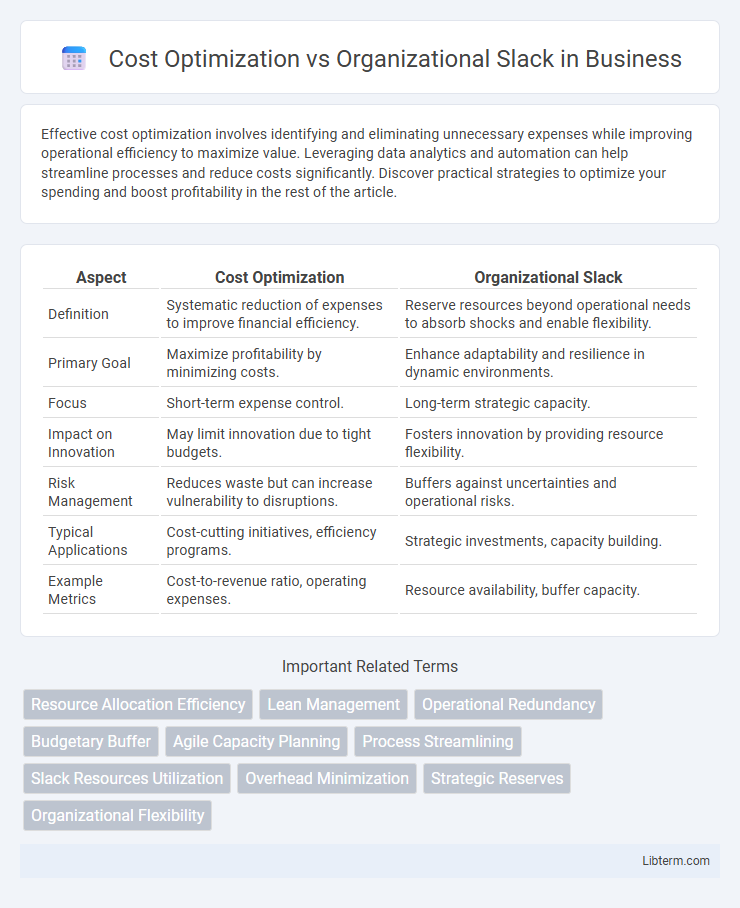Effective cost optimization involves identifying and eliminating unnecessary expenses while improving operational efficiency to maximize value. Leveraging data analytics and automation can help streamline processes and reduce costs significantly. Discover practical strategies to optimize your spending and boost profitability in the rest of the article.
Table of Comparison
| Aspect | Cost Optimization | Organizational Slack |
|---|---|---|
| Definition | Systematic reduction of expenses to improve financial efficiency. | Reserve resources beyond operational needs to absorb shocks and enable flexibility. |
| Primary Goal | Maximize profitability by minimizing costs. | Enhance adaptability and resilience in dynamic environments. |
| Focus | Short-term expense control. | Long-term strategic capacity. |
| Impact on Innovation | May limit innovation due to tight budgets. | Fosters innovation by providing resource flexibility. |
| Risk Management | Reduces waste but can increase vulnerability to disruptions. | Buffers against uncertainties and operational risks. |
| Typical Applications | Cost-cutting initiatives, efficiency programs. | Strategic investments, capacity building. |
| Example Metrics | Cost-to-revenue ratio, operating expenses. | Resource availability, buffer capacity. |
Introduction to Cost Optimization and Organizational Slack
Cost optimization involves strategically reducing expenses to maximize efficiency and profitability without compromising value, utilizing techniques such as process improvement, resource allocation, and technology adoption. Organizational slack refers to excess resources or capacity within a company that provides a buffer for innovation, risk-taking, and adaptability during market fluctuations. Balancing cost optimization with organizational slack is essential for sustaining competitive advantage while maintaining operational flexibility.
Defining Cost Optimization in Modern Organizations
Cost optimization in modern organizations involves strategically managing expenditures to maximize value while maintaining operational efficiency and competitiveness. It emphasizes aligning costs with business goals through data-driven decision-making, process improvements, and technology investments that reduce waste without compromising quality. Effective cost optimization balances resource allocation and risk, avoiding excessive organizational slack that can hinder agility and innovation.
Understanding Organizational Slack: Purpose and Types
Organizational slack refers to the cushion of resources available within a company, such as excess capital, workforce capacity, or time, which allows flexibility in responding to unexpected challenges and seizing new opportunities. There are three primary types of organizational slack: absorbed slack involves resources fully allocated but potentially reallocated, unabsorbed slack includes reserves like cash or inventory readily accessible, and potential slack comprises untapped resources waiting to be activated. Understanding the purpose of organizational slack is essential for balancing cost optimization efforts with maintaining strategic agility and resilience in dynamic market conditions.
The Strategic Role of Cost Optimization
Cost optimization strategically aligns resource allocation to maximize efficiency and profitability while minimizing waste, directly impacting organizational agility and competitive advantage. Unlike organizational slack, which represents excess capacity or resources held as a buffer for uncertainty, cost optimization ensures lean operations without sacrificing critical capabilities. Effective cost optimization drives sustainable growth by enabling firms to reinvest savings into innovation and core business activities, enhancing long-term value creation.
Advantages and Risks of Organizational Slack
Organizational slack provides a buffer of resources that allows companies to adapt quickly to market changes and invest in innovation, fostering long-term resilience and competitive advantage. However, excessive slack can lead to inefficiencies, resource misallocation, and reduced pressure on management to optimize costs, diminishing overall organizational performance. Balancing slack is crucial to maintaining flexibility without sacrificing operational discipline or financial health.
Comparative Analysis: Cost Optimization vs Organizational Slack
Cost optimization prioritizes reducing expenses to improve financial efficiency, often involving stringent budget controls and lean resource allocation. Organizational slack refers to the surplus resources within a company that provide flexibility to absorb shocks, support innovation, and adapt to change without immediate cost reductions. Comparative analysis highlights that while cost optimization drives short-term fiscal discipline, organizational slack fosters long-term resilience and strategic agility by maintaining resource buffers.
Balancing Efficiency and Flexibility in Operations
Cost optimization enhances operational efficiency by minimizing unnecessary expenditures and streamlining resource allocation, directly impacting a company's profitability and competitive edge. Organizational slack, defined as excess resources available beyond the minimum necessary, provides flexibility and resilience, enabling businesses to absorb shocks and pursue innovative opportunities without compromising ongoing operations. Balancing cost optimization with strategic slack ensures firms maintain lean operations while retaining the agility to adapt swiftly to market changes and unexpected challenges.
Impact on Innovation and Employee Morale
Cost optimization enhances resource allocation efficiency but can limit innovation by reducing experimentation budgets, leading to constrained creative output. Organizational slack, manifested as extra capacity or resources, fosters a culture of innovation by allowing employees to explore new ideas without immediate pressure for returns. Balancing cost optimization with sufficient slack is critical to maintaining employee morale and sustaining long-term innovation.
Best Practices for Aligning Slack with Cost Control
Effective alignment of organizational slack with cost control involves implementing strategic resource buffers that prevent operational disruptions without inflating expenses. Best practices include precise measurement of slack levels based on real-time performance data and integrating predictive analytics to adjust slack dynamically in response to demand variability. Leveraging cost optimization tools alongside flexible budgeting frameworks ensures that slack contributes to resilience while maintaining fiscal discipline.
Conclusion: Strategic Recommendations for Leaders
Leaders should balance cost optimization with maintaining sufficient organizational slack to foster innovation and agility, ensuring resilience in volatile markets. Emphasizing targeted investments in critical capabilities enables cost discipline without sacrificing flexibility or employee morale. Strategic resource allocation guided by data-driven insights optimizes performance while preserving an adaptive buffer for unforeseen challenges.
Cost Optimization Infographic

 libterm.com
libterm.com